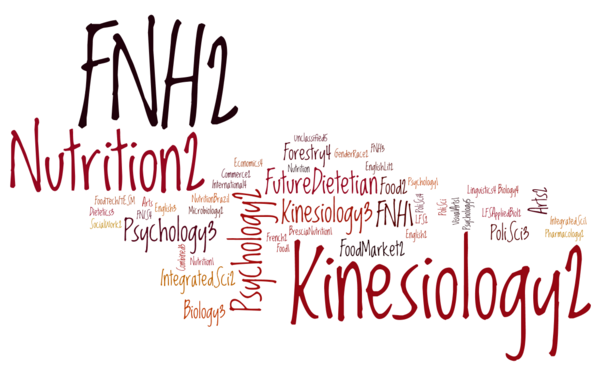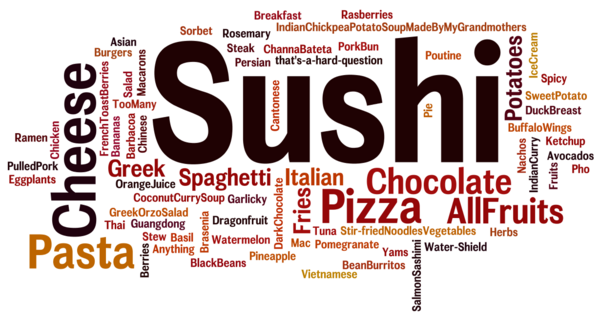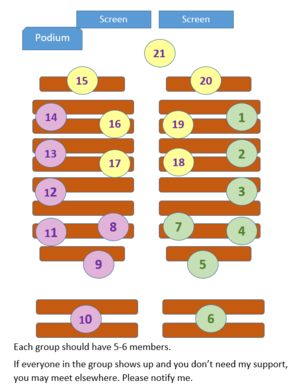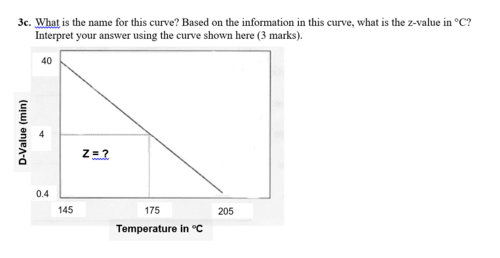Course:FNH200/2015w2/Lecture Notes
Hi Class,
This is where I will post or jot down highlights and latest updates from each class.
Judy
Friday, January 1, 2016: Pre-Class Survey and E-mail
Hi Class,
Before you come to class on Monday, I would like to invite you all to complete three tasks:
- Complete this quick pre-class survey: https://survey.ubc.ca/s/FNH200102_2015w_PreClassSurvey/
- Review the course syllabus, which you may access via: http://wiki.ubc.ca/Course:FNH200
- a link near the bottom of your first screen
- or a link in the Infobox on the right panel
- Browse through the first lesson:
See you on Monday!
Judy
Monday, January 4, 2016: Introduction
- The Course: Syllabus
- Me
- Beginning of Lesson 01
Questions:
Job: Internship - Info about the BCFT events on Facebook
http://bcft.ca/upcoming_events.html
- Thursday, January 21, at Food, Nutrition and Health Building
- Free for Student Members
- $10 for Student Non-Member
Survey: Our Academic Background
Survey: Our Favourite Foods
Survey: What You Want to Learn?
You Won't Be Disappointed
- The science behind taste (Yes, Lesson 3); Why some things pair better than others (No, sorry)
- The newest technology for it today and why it's so good (All lessons)
- The different properties food may have in response to what we do to them (All lessons)
- How to deal with food instability (Lessons 5, 6, 7, and 8)
- Postharvest treatment of fruits and vegetables (Lessons 1, 5, 6, 7, 8, and 9)
- Food stripped down to the basics - the origins, the industry and the policies governing production and distribution (Some, Lesson 4)
- How to better store foods to get the most out of buying in big quantities (Lessons 5, 6, 7, and 8)
- I want to learn about how preservatives and additives are used in the food industry (Lesson 4)
- How best before dates are determined (Lesson 4)
- Regulations for selling and nutritional content of food (Lessons 4 and 11)
- How are foods processed (Lessons 5, 6, 7, 8, and 9)
Will Be Briefly Explored
- Basic nutrition outline to maintain health
- What is the most balanced diet for a healthy constitution?
- I want to learn about nutrition overall as well as the geo-political issues concerning food (sorry!)
- How to plan a nutritious meal and maintain a healthy diet
- Which foods to eat to help with certain health issues
- I want to learn about how to eat sustainably for the environment, and sustainably to be an athlete (sorry, though this is an important topic)
- The nutritional value in different foods
- How it affects our growth, specifically the growth of our muscles
- Best food for athletes under specific conditions
Answers to Some Selected Questions
| Your Questions | My Responses |
|---|---|
| If there's one thing you want your students to take away from the course, what would that be? | Processing is necessary in the way we live; I hope you will gain the skills to justify why you choose one processed food over others |
| Will there be sampling? | Absolutely! |
| What advices can you give to me so I can deal better with your course and also with the Canadian system of Univertisy education in general? | Let's chat! |
|
|
| Project Guideline? | Will be ready by January 20. |
|
|
| Why are we allowed only one cheat sheet for the exam? |
I consider the use of 'cheat sheet' is indeed a way to test your note-taking skills.
By the way:
|
| How to study for a science course? I'm used to text and paper-writing. | There will be a lot of information and facts. You need to find ways to weave, connect individual pieces of information to form a network of knowledge that makes sense to you. Again, chat with me! Let's develop a plan together. |
| Where do you see the future of food going? 3D printed? | Unfortunately, more processing is inevitable to feed the world's population. My personal biggest concern is the amount of packaging we are using; I wish we can find a 'new' plastic that doesn't hurt our environment as much as the plastics we are currently using. |
| What is the difference between Judy and the other instructors? | I don't know :) Please tell me what you think by April. |
Wednesday, January 6: Lesson 1
I like to finish Lesson 1 today...
January 8 to 13: Lesson 2
We watched this video for fun:
Friday, January 15: Lesson 2, Emulsion, protein water
I plan to finish Emulsion, Protein, and Water today.
No more required reading in Lesson 2
That's it. No more required reading. The two articles posted in Lesson 02 are no longer required.
What about FAT???
I still really want you to know about the chemistry behind margarine (and the formation of 'trans' fat). I will prepare a new side page with exactly what you will need to know by Monday.
Monday, January 18: MARGARINE!!! IMPORTANT!!!
You need to know the relationship among the different types of fats in margarine for the midterm and probably for the final!!!
Poem on Pain au Chocolat
Pain-au-chocolat
 Chocolate croissant with flaky and moist interior and melting chocolate
Chocolate croissant with flaky and moist interior and melting chocolate
Bking in the oven
The aroma is so sweet
The scent welcomes you in
The warm feeling of heat
Flaky as you bite
Moist as you chew
The chocolate in sight
Will melt in your mouth too
Delicious, can't get enough
Even after a ton
Though it may be tough,
Now you're ready for another one
-by Sabrina-
Wednesday, January 20: Lesson 3
Nothing really exciting happened today. I started talking about the team project.
Friday, January 22: Team Working Day
Today, you may want to:
1. Introduce yourself to each other; talk about what your favourite foods are; exchange contact info; remember what they look like
2. Author PeerWise questions together
To access PeerWise for the first time as a team, you will need to do the following:
- Go to http://peerwise.cs.auckland.ac.nz/at/?ubc_ca
- Click Register, on the right bottom corner
- Pick a username, pick a team name; A team name like TEAM123 is practical, but you may also want to pick something creative and fun :)
- Pick a password, please pick a password that's easy enough that everyone on the team can remember
- Enter your PeerWise Course ID = 12475
- Enter your team identifier, as posted on your Connect Grade Centre (5 digit; the last two digits show your team number)
You may now author questions together. As a team, you need to author at least three questions before Monday and one of them should receive 'above average rating' to receive full mark.
To answer PeerWise questions individually, you will need to set up a personal account using the same steps above. You need your individual login/ID to answer questions
- Go to http://peerwise.cs.auckland.ac.nz/at/?ubc_ca
- Click Register, on the right bottom corner
- Pick a username, preferably a name not associated with your real name. For the purpose of this course, some suggestions include 'foodie', 'foodguard', 'madscientist', 'chocolatier', 'listeriosis', etc.
- Pick a password, any password that you normally use will do
- Enter your PeerWise Course ID = 12475
- Enter your individual identifier, as posted on your Connect Grade Centre (4 digit)
On your own, answer at least 6 questions and comments on two before 12 noon on January 27 to get full mark.
3. Brainstorm possible team project topics
Three criteria: 1. Traditional foods 2. Not so well covered on wikipedia.com yet 3. Sufficient information from reliable sources
Week of January 25 to 29
Monday
- Complete Lesson 03
- Review midterm format
Wednesday
- Midterm
- Mark should be up on Connect over the weekend
Friday: Library Research Skills
- Review library research skills that had been covered in English 112, LFS 100, and LFS 150
Wednesday, February 10: Midterm Feedback and Lesson 5
[My responses to your suggestions.]
February 22 to 24: Lesson 06
Some practice questions on processing time:
1. A pathogenic microorganism has a decimal reduction time of 5 minutes in tomato juice when processed at 91 oC. How long should it be processed to sterilize the juice (pH = 3.8)?
A. 25 seconds B. 60 seconds C. 5 minutes D. 25 minutes E. 60 minutes
2. A pathogenic microorganism has a decimal reduction time of 5 minutes in tomato juice when processed at 91 oC. If this juice has a Z-value of 5 oC, what is it’s D-value at 121 oC?
A. 0.0003 seconds B. 0.003 seconds C. 0.05 seconds D. 0.3 seconds E. 5 seconds
3. A pathogenic microorganism has a decimal reduction time of 5 minutes in tomato juice when processed at 91 oC. If this juice has a Z-value of 5 oC, what is it’s F-value?
A. 0.0003 seconds B. 0.003 seconds C. 0.05 seconds D. 0.3 seconds E. 5 seconds
4. A pathogenic microorganism has a decimal reduction time of 5 minutes in tomato juice when processed at 91 oC. If this juice has a Z-value of 5 oC, how long should it be processed at 121 oC?
A. 0.003 seconds B. 0.015 seconds C. 0.036 seconds D. 0.06 seconds E. 5 seconds
A question from a past exam:
Monday, February 29, 2016: Lesson 07, Low Temperature Preservation
Individually Quick Freeze (IQF) of sardines:
How to Make Frozen Treats:
Watch the video above and pay special attention to:
- The freezing technique
- The freezant
- Pasteurizing condition of the 'filling'
- Definition of homogenization of the ‘filling’
- Shelf Life and storage Instruction of the final product
This is also fun to watch! The first couple minutes are indeed packed with terminologies that we've explored in previous lessons. This is a good opportunity to review the many terms mentioned in the beginning of this clip.
Wednesday, March 2: Dehydration
Before I start the day, I really want to show you this:
Secret to Happy Brain:
Dehydrated food snacking day! Pay attention to the dehydration methods used for the different food samples distributed in class today.
For fun!
Friday, March 4: Team Day
A 10-minute presentation from our UBC Wikipedia Ambassador
- It's is best to start posting your research finding on the SANDBOX page
- The experts will be able to answer questions you may have
There are many outstanding tasks you must all complete by Monday, March 7, grade associated:
- Two members from each team must complete the library research skills modules (in Connect)
- Two members from each team must complete the wikipedia overview (in Wikipedia)
- iPeer evaluation (in Connect), the evaluation is still available, but will be closed by March 7!!!
- Post your project outline in the 'TALK' page of your wikipedia article page
Other tasks you may want to complete:
- PeerWise questions generating
Monday, March 7: Midterm sample questions
Link to view midterm samples questions:
https://docs.google.com/presentation/d/1a9f2Mpk-l47-3vB7j8szqeuswvwYV59L4a0OWNoGmEI/edit?usp=sharing
Wednesday, March 9: Midterm #2
You are expected to know:
- Complete PeerWise task on your own: answer six questions and comment on two
- Lesson 01: controlled atmosphere storage
- Lesson 02: water activity, pH, browning
- Lessons 4, 5, 6, 7, and 8
Format, same as last time:
- Multiple choice questions (bring pencils and erasers)
- Individual first, then team
- A single-sided 8.5 inch by 11 inch page of memory aided, no stickies, no extension0
- Individual
A Note on Lesson 4 Required Readings
- Health Canada, Food program: Safety of Aspartame (http://www.hc-sc.gc.ca/fn-an/securit/addit/sweeten-edulcor/aspartame-eng.php)
- This is to supplement existing notes on aspartame in Lesson 4. Additional information is not needed.
- From Lesson 3: Kroger, M, Meister, K. and Kava, R. 2006. Low-calorie sweeteners and other sugar substitutes: A review of the safety issues. Comprehensive Reviews in Food Science and Food Safety 5: 35-47 (read esp pp. 37-39).
- You should read this to get a sense of how aspartame became approved and how limits are set.
- Hotchkiss, J.H. and Cassens, R.G. 1987 [April]. Nitrate, nitrite and nitroso compounds in foods (A scientific status summary). Food Technology, 41(4):127-136.
- I like to highlight the relationships of these compounds and where they can be found.
- Health Canada. 2006. Food Additive Dictionary. Publication H49-10/1996E. Ottawa: Health Canada.
- You have used this for your assignment. There is no need to review this for the midterm.
Friday, March 11: Team Day again
Guest librarian and Wikipedia support staff will be here. There will be a 10-minute exercise on citations on Wikipedia articles. Then it's your time to work on the project. To make the best use of available expertise available on Friday, I strongly advise you to:
- Start posting some draft information on a SANDBOX that belongs to one of your teammates
- Start making some basic editing: set headings, subheadings, etc.
- Try adding some images and hyperlinks
- Attempt to add citations - info on how to cite on Wikipedia is available here: https://en.wikipedia.org/wiki/Help:Referencing_for_beginners
Monday and Wednesday, March 14 and 16: Lesson 09
Fermentation of soy sauce in two types of production facilities:
Small scale production
LARGE scale production
Cheese Making
This is a pretty easy to follow clip, a bit funny and has all necessary science content needed for FNH 200
This shows less science, but the machine is shinier than those in the clip above.
This video is even clearer than the one above, but I feel there is less science content.
Friday, March 18: Team Day
Monday and Wednesday, March 21 and 23: Lesson 10
Wednesday, March 23: Project Due
This is indeed a very good introduction/summary of how irradiation works as a food preservation technique.
Quick Feedback on Projects
Team Instant Mashed Potato and Peanut Butter!
I would like to encourage you to do some quick simple copy and paste to share what you had researched on the main article page. You've done some great work! Share with the world!
Friday and Monday, March 25 and 28: Day Off
Wednesday, March 30: Back to 'normal'
- Instructions on Assignment #3 (2% of course grade, due April 15) can be found here: | Assignment #3 Instruction
Course Evaluation: There are TWO course evaluations.
- The usual one: The one that you normally do for all other courses.
- A bonus one: A slight longer survey that is done for all FNH 200 sections. There is a 0.5% bonus for completing this.
Friday, April 8: Last day of class & Review
- Complete PeerWise #3 Question Creation (creating 3 questions per team)
- Complete your second peer evaluation on Connect (iPeer)
- Instructions on Assignment #3 (2% of course grade, due April 15) can be found here: | Assignment #3 Instruction
- Course Evaluation: There are TWO course evaluations.
- The usual one: The one that you normally do for all other courses.
- A bonus one: A slight longer survey that is done for all FNH 200 sections. There is a 0.5% bonus for completing this.
Final Review Notes
File:FNH200 Final Jeopardy.pdf
File:FNH200 Final ShortAnswer Examples.pdf
Friday, April 15, 3:30 pm
- Assignment #3
- Instruction: Assignment #3
Wednesday, April 20, 3:30 pm: Final Exam
- Complete PeerWise #3 Question Answering (answer 6 and comment on two per person)
Location: Scarf Room 100
All lessons 1 to 13, 2.5 hours
Format:
- roughly 70 to 85% of mark will be from multiple choice questions (individual and team)(Judy promised to have less than 55 questions)
- roughly 15 to 30% of mark will be from short answer questions (individual only)
- You will have 90 minutes to complete the individual components (multiple-choice questions and short answer questions). You must stay till the end of the 90 minutes for the team component. If you finish before 90 minutes and checked over all the answers three times, it is best to use the time to take a nap. If you really really need/want to study for another course, you may study text-based materials after submitting your own FNH 200 102 exam and with permission from Judy.
Memory Aide: 11 by 8.5 double sided
Creating Useful Memory Aide
First of all, I hope that you recognize the use of a memory-aide (or commonly known as cheat sheets) is a way to practice your summarizing skills. Beyond lists and tables of facts,
- Are you able to identify the key information and concepts in the lessons?
- What information is needed to help you understand and integrate the concepts?
- How can you arrange your notes so that you can find what you need during the exam when you are under tremendous pressure?
I really like to the 5R method introduce in the last minute of this video: Record, Reduce, Recite, Reflect and Review.
Exam: 7 tips for making great study notes:
http://www.studentawards.com/stacks/tips/exams-study-notes.aspx
Visual learners often find it useful to connect concepts using concept maps:



